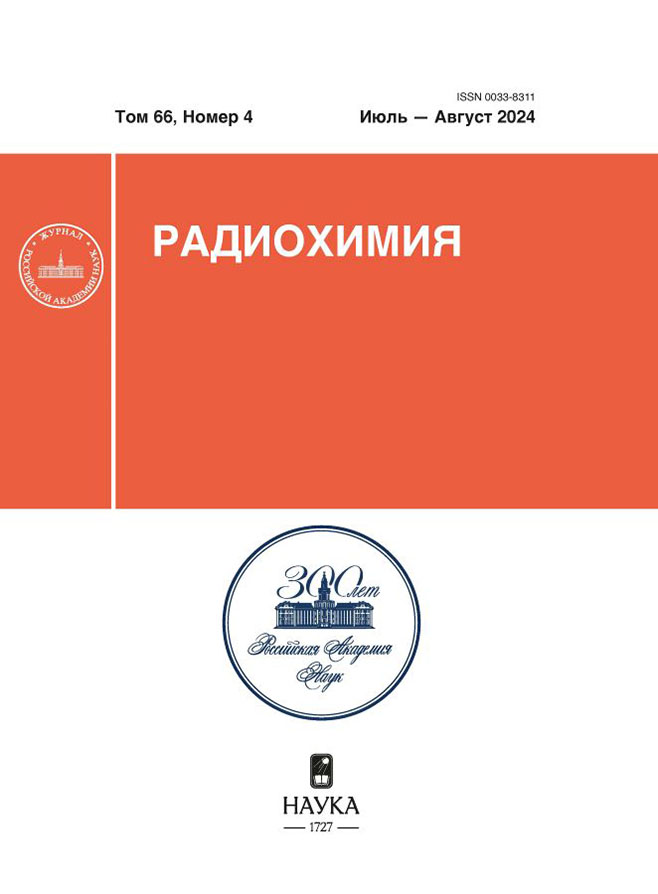Method of coupled processes in studying diffusion of radioactive waste elements in the pore solution of clay materials
- 作者: Martynov K.V.1, Zakharova E.V.2
-
隶属关系:
- Frumkin Institute of Physical Chemistry and Electrochemistry
- Frumkin Institute of Physical Chemistry and Electrochemistry, Russian Academy of Sciences
- 期: 卷 66, 编号 4 (2024)
- 页面: 388-398
- 栏目: Articles
- URL: https://consilium.orscience.ru/0033-8311/article/view/686229
- DOI: https://doi.org/10.31857/S0033831124040114
- ID: 686229
如何引用文章
详细
A method of coupled processes was proposed to maintain concentrations in the model leachate of the radioactive waste phosphate matrix, which served as a source of elements in the study of through-diffusion of P, Se, Br, Mo, Cs, and U in the pore solution of compacted clay materials. The method consisted in adding an leachatable solid phase to the solution in the source chamber of the diffusion cell. The use of this method made it possible to stabilize the boundary conditions and expand the range of element concentrations in the source chamber of diffusion cells. The new as-obtained data on the effective diffusion coefficients of radioactive waste elements in clay rocks were used to refine the empirical models of diffusion transfer. It is shown that in different geochemical systems (model groundwater and phosphate glass leachate) for some elements (Br, Mo, Cs) it is possible to use unified models in the form of effective diffusion coefficients as a function of factors influencing this process: sample porosity, smectite content in the sample, and concentration of radionuclide (element) in pore solution, while for Se and U, diffusion models for various geochemical systems differ. The specificity of diffusion behavior of elements is associated with structural features and physicochemical properties of particles of these elements in aqueous solutions.
全文:
作者简介
K. Martynov
Frumkin Institute of Physical Chemistry and Electrochemistry
编辑信件的主要联系方式.
Email: mark0s@mail.ru
俄罗斯联邦, Moscow, 119071
E. Zakharova
Frumkin Institute of Physical Chemistry and Electrochemistry, Russian Academy of Sciences
Email: mark0s@mail.ru
俄罗斯联邦, Moscow, 119071
参考
- Garcia-Gutierrez M., Cormenzana J.L., Missana T., Mingarro M., Molinero J. // J. Iber. Geol. 2006. Vol. 32. N 1. P. 37.
- Wolfrum C., Lang H., Moser H., Jordan W. // Radiochim. Acta. 1988. Vol. 44/45. Р. 245.
- Lee C.-P., Hu Y., Chen D., Wu E., Wang Z., Wen Z., Tien N.-C., Yang F., Tsai S.-C., Shi Y., Liu Y.-L. // Materials. 2021. Vol. 14. N 22. P. 7056.
- Мартынов К.В., Коневник Ю.В., Захарова Е.В. // Радиохимия. 2023. Т. 65. № 4. С. 364.
- Martynov K.V., Zakharova E.V. // Radiochemistry. 2024. Vol. 66. N 2. P. 212–226.
- Вашман А.А., Демин А.В., Крылова Н.В., Кушников В.В., Матюнин Ю.И., Полуэктов П.П., Поляков А.С., Тетерин Э.Г. // Фосфатные стекла с радиоактивными отходами / Под ред. А.А. Вашмана, А.С. Полякова. – М.: ЦНИИатоминформ, 1997. – 172 с.
- Кочкин Б.Т., Мальковский В.И., Юдинцев С.В. Научные основы оценки безопасности геологической изоляции долгоживущих радиоактивных отходов (Енисейский проект). – М.: ИГЕМ РАН, 2017. – 384 с.
- Абрамов А. А., Большов Л. А., Дорофеев А. Н., Игин И. М., Казаков К. С., Красильников В. Я., Линге И. И., Трохов Н. Н., Уткин С. С. // Радиоактивные отходы. 2020. №1 (10). С. 9.
- Мартынов К.В., Захарова Е.В. // Радиоактивные отходы. 2023. № 2 (23). С. 63.
- Oscarson D. W., Hume H. B., Sawatsky N. G., H. Cheung S. C. // Soil Sci. Soc. Am. J. 1992. Vol. 56. N 5. P. 1400.
- Lee J.O., Cho W.J., Hahn P.S., Park H.H. // J. Korean J. Korean Nucl. Soc. 1994. Vol. 26. N 2. P. 285.
- Wu T., Li J., Dai W., Xiao G.-P., Shu F.-J., Yao J., Su Y.-L., Shi L. // Sci. China Chem. 2012. Vol. 55. P. 1760.
- Tachi Y., Yotsuji K. // Geochim. Cosmochim. Acta. 2014. Vol. 132. P. 75.
- Fukatsu Y., Yotsuji K., Ohkubo T., Tachi Y. // Appl. Clay Sci. 2021. Vol. 211. Art. 106176.
- Tsai T.-L., Tsai S.-C., Chang D.-M., Cheng W.-H. // J. Radioanal. Nucl. Chem. 2021. Vol. 330. P. 1317.
- Wang C., Myshkin V. F., Khan V. A., Panamareva A. N. // J. Radioanal. Nucl. Chem. 2022. Vol. 331. P. 3401.
- Wang Z., Wang H., Li O., Xu M., Guo Y., Li J., Wu T. // Appl. Geochem. 2016. Vol. 73. P. 1.
- Ochs M., Lothenbach B., Wanner H., Sato H., Yui M. // J. Contam. Hydrol. 2001. Vol. 47. P. 283.
补充文件














